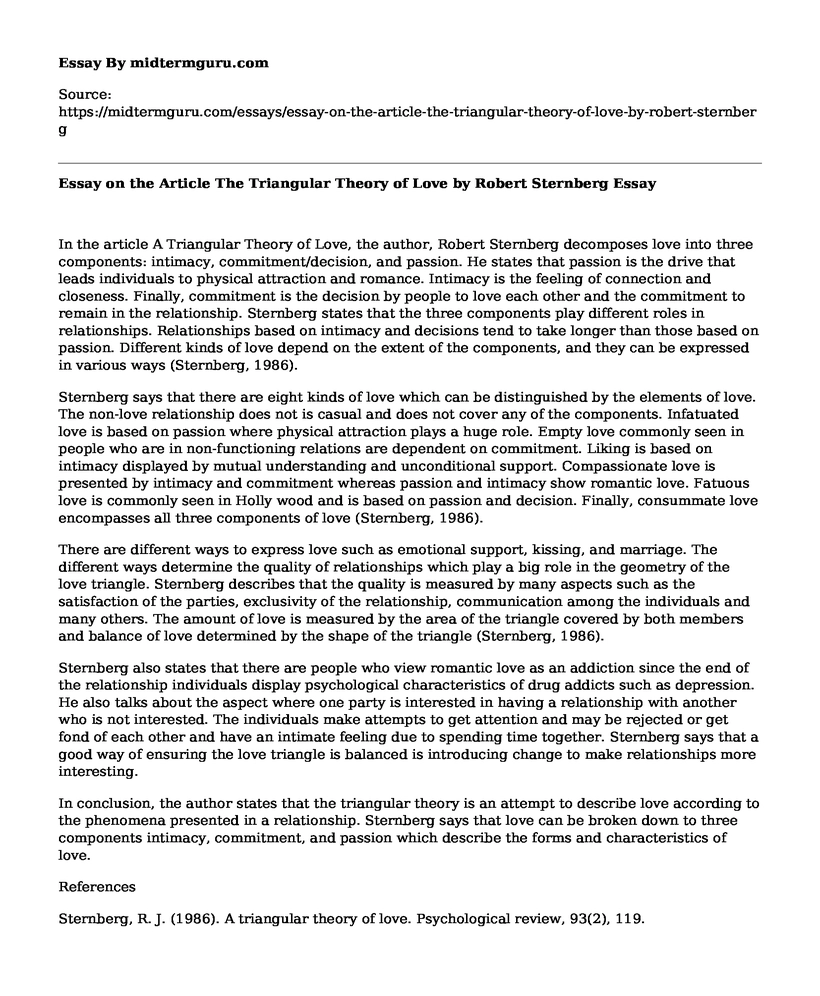In the article A Triangular Theory of Love, the author, Robert Sternberg decomposes love into three components: intimacy, commitment/decision, and passion. He states that passion is the drive that leads individuals to physical attraction and romance. Intimacy is the feeling of connection and closeness. Finally, commitment is the decision by people to love each other and the commitment to remain in the relationship. Sternberg states that the three components play different roles in relationships. Relationships based on intimacy and decisions tend to take longer than those based on passion. Different kinds of love depend on the extent of the components, and they can be expressed in various ways (Sternberg, 1986).
Sternberg says that there are eight kinds of love which can be distinguished by the elements of love. The non-love relationship does not is casual and does not cover any of the components. Infatuated love is based on passion where physical attraction plays a huge role. Empty love commonly seen in people who are in non-functioning relations are dependent on commitment. Liking is based on intimacy displayed by mutual understanding and unconditional support. Compassionate love is presented by intimacy and commitment whereas passion and intimacy show romantic love. Fatuous love is commonly seen in Holly wood and is based on passion and decision. Finally, consummate love encompasses all three components of love (Sternberg, 1986).
There are different ways to express love such as emotional support, kissing, and marriage. The different ways determine the quality of relationships which play a big role in the geometry of the love triangle. Sternberg describes that the quality is measured by many aspects such as the satisfaction of the parties, exclusivity of the relationship, communication among the individuals and many others. The amount of love is measured by the area of the triangle covered by both members and balance of love determined by the shape of the triangle (Sternberg, 1986).
Sternberg also states that there are people who view romantic love as an addiction since the end of the relationship individuals display psychological characteristics of drug addicts such as depression. He also talks about the aspect where one party is interested in having a relationship with another who is not interested. The individuals make attempts to get attention and may be rejected or get fond of each other and have an intimate feeling due to spending time together. Sternberg says that a good way of ensuring the love triangle is balanced is introducing change to make relationships more interesting.
In conclusion, the author states that the triangular theory is an attempt to describe love according to the phenomena presented in a relationship. Sternberg says that love can be broken down to three components intimacy, commitment, and passion which describe the forms and characteristics of love.
References
Sternberg, R. J. (1986). A triangular theory of love. Psychological review, 93(2), 119. http://pzacad.pitzer.edu/~dmoore/psych199/1986_sternberg_trianglelove.pdf
Cite this page
Essay on the Article The Triangular Theory of Love by Robert Sternberg. (2021, Jun 14). Retrieved from https://midtermguru.com/essays/essay-on-the-article-the-triangular-theory-of-love-by-robert-sternberg
If you are the original author of this essay and no longer wish to have it published on the midtermguru.com website, please click below to request its removal:
- The Psychology of Adolescence - Research Paper
- Post-Traumatic Stress Disorder on Soldiers - Paper Example
- Research Paper on Social, Moral Issues
- Mental Illness as a Subculture: Common Attitudes and Beliefs - Essay Sample
- Understanding Human Behavior and Its Relationship to Family Bonds - Essay Sample
- Mental Health: Its Impact on Development, Childhood, Adolescence & Adulthood - Essay Sample
- The Uncanny: Exploring the Dual Meaning of Fear and Horror - Essay Sample







